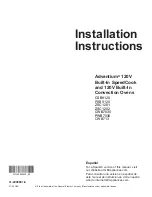
24
INSTALLATION
Connecting the Range to Gas
Shut off the range gas supply valve before removing
the old range and leave it off until the new hook-up
has been completed.
Because hard piping restricts movement of the range,
a CSA International-certified flexible metal appliance
connector should be used unless local codes require
a hard-piped connection.
A manual valve must be installed in an accessible
location in the gas piping external to the appliance
for the purpose of turning on or shutting off gas to the
appliance.
Never reuse an old connector when installing a new
range.
To protect against gas leaks, use a qualified pipe joint
sealant on all external threads.
1
An inlet pipe is set on the left rear of this
appliance. Hook up a gas hose that has
1
/
2
" NPT
internal thread to the inlet pipe using a wrench.
2
Apply sealing compound or Teflon tape at the
connection.
3
When all connections have been made, be sure
all range controls are in the
Off
position and turn
on the main gas supply valve. Gas leaks may
occur in your system and create a hazard. Gas
leaks may not be detected by smell alone.
Check all gas connection joints and fittings for
leaks with a non-corrosive leak detection fluid,
then wipe off.
Gas suppliers recommend you purchase and
install a UL approved gas detector. Install
and use in accordance with the installation
instructions.
WARNING
%
Do not use a flame to check for gas leaks.
%
Isolate the range from the gas supply system
by closing its individual shut-off valve during
any pressure testing of the gas supply system
at test pressures equal to or less than
1
/
2
" psig
(3.5 kPa).
Flexible Connector Hookup
1
/
2
"
Adapter
Pressure regulator
Flex connector
(6 ft. max.)
Adapter
Gas shut-off
valve
1
/
2
" or
3
/
4
" Gas
pipe
Gas Flow into Range
Installer: Inform the consumer of the location of the gas
shutoff valve
.
Pressure Regulator Position
Pressure Regulator
NOTE
Use a coin to unscrew the circular cap on the
pressure regulator.
















































